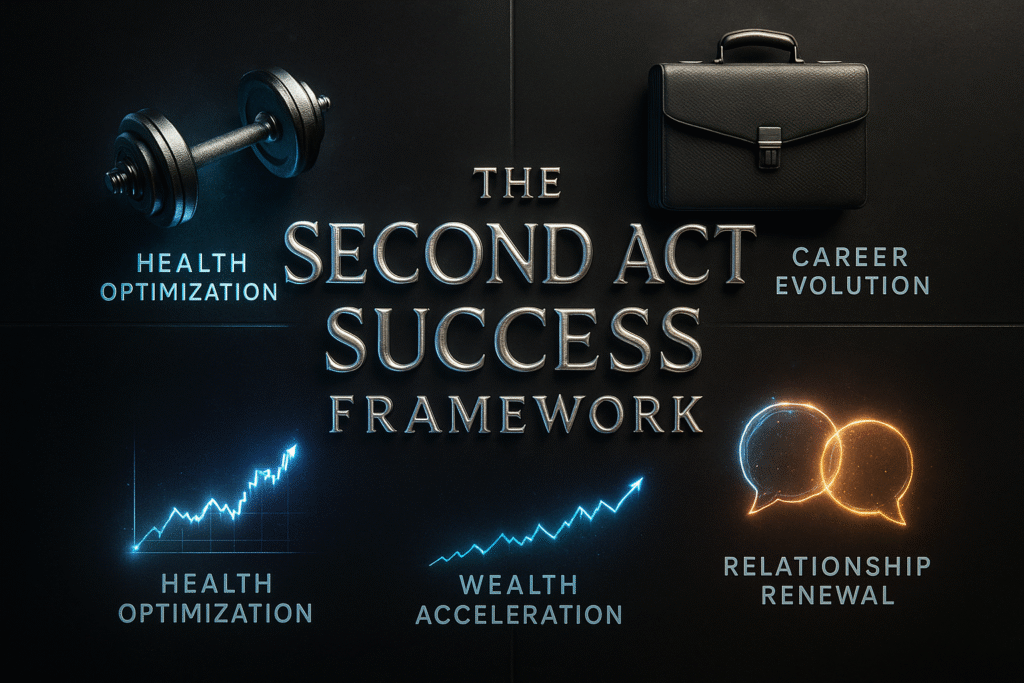The Midlife Reboot: A Man’s Guide to Mastering the Second Act

Estimated Reading Time: 25 minutes
Table of Contents
For decades, the narrative of a man’s life past forty has been dominated by a single, dreaded term: the midlife crisis. It conjures images of reckless sports car purchases, questionable fashion choices, and a desperate, often clumsy, attempt to recapture lost youth. But what if that narrative is wrong? What if the entire concept of the midlife crisis, as we know it, is dead?
Recent research from 2025, analyzing data from over 10 million adults, suggests a profound shift in the landscape of middle age [1]. The classic, dramatic unraveling is no longer the norm. Instead, we’re seeing a new reality emerge—one defined not by crisis, but by opportunity. This isn’t a period of decline to be feared, but a strategic “second act” to be mastered. After reviewing dozens of studies and speaking with experts in the fields of health, finance, and psychology, it’s clear that men in their 40s, 50s, and 60s are uniquely positioned for their most powerful and fulfilling decades.
This guide is your roadmap to navigating this new territory. We will dismantle the outdated crisis narrative and provide you with a comprehensive, evidence-based framework for a successful midlife reboot. You will gain access to the same strategic tools and mindset shifts used by top performers to transform their health, evolve their careers, accelerate their wealth, and deepen their relationships. Forget what you’ve been told about middle age. It’s time to master your second act.
Section 1: The New Midlife Reality: Why the Midlife Crisis is Dead (And What Replaced It)
The idea of the midlife crisis, first coined in the 1960s, has become a cultural shorthand for a period of intense emotional turmoil. It was seen as an inevitable, almost universal, experience for men entering their middle years. However, the world has changed dramatically since then, and so have the men navigating it. The data now paints a very different picture. A landmark 2025 study, which surveyed over 10 million adults, revealed that the classic, dramatic midlife crisis is no longer a statistical norm [1]. Instead, we are witnessing a fundamental shift in how men experience their 40s, 50s, and beyond.
This isn’t to say that midlife is without its challenges. The same research highlights a concerning rise in mental distress, with rates for men more than doubling from 2.5% in 1993 to 6.6% in 2024 [2]. However, the key distinction is that this distress is no longer concentrated in the middle years. In fact, the most severe mental health struggles are now seen in young adults in their early twenties. This suggests that the pressures of modern life are being felt earlier and more acutely, but it also means that men who have successfully navigated the early stages of their careers and personal lives are arriving at midlife with a greater degree of resilience and self-awareness.
So, what has replaced the midlife crisis? The evidence points to a new paradigm: the Midlife Reboot. This is not a period of desperate flailing, but one of conscious, strategic re-evaluation. It’s a time when men are leveraging their accumulated experience, wisdom, and resources to optimize their lives for the decades to come. This is supported by research from Stanford Medicine, which has identified two key periods of rapid biological change in our 40s and 60s. As senior author Michael Snyder, PhD, explains:
“We’re not just changing gradually over time; there are some really dramatic changes. It turns out the mid-40s is a time of dramatic change, as is the early 60s. And that’s true no matter what class of molecules you look at.” [3]
These biological shifts, particularly those related to cardiovascular health and immune function, are not random. They represent critical windows of opportunity for intervention. By understanding these changes, men can take proactive steps to optimize their health and well-being, setting the stage for a vibrant and energetic second act. This is a far cry from the reactive, often destructive, behaviors associated with the old crisis narrative.
Furthermore, the economic landscape has also reshaped the midlife experience. While financial pressures are a real concern, particularly for millennials, with 81% stating they can’t afford a midlife crisis [4], this has also fostered a more pragmatic and resourceful approach to life transitions. Men are no longer simply reacting to a sense of existential dread; they are making calculated decisions about their careers, finances, and lifestyles. This is reflected in career change statistics, which show a peak in job transitions between the ages of 35 and 44 [5]. This isn’t a sign of instability, but of a proactive desire to find more fulfilling and meaningful work.
In essence, the midlife crisis has been replaced by a more nuanced and empowering reality. The modern man is not a victim of circumstance, but an active architect of his own future. The second act is not a consolation prize, but the main event. It’s a time to leverage the wisdom of the past to create a future that is not just successful, but significant. but significant.
Section 2: The Second Act Success Framework: Four Pillars of Transformation

A successful midlife reboot is not a haphazard affair. It requires a structured, holistic approach that addresses the key domains of a man’s life. After analyzing the habits of high-performing men who have successfully navigated their second act, a clear pattern emerges. Their success is built upon four interconnected pillars: Health Optimization, Career Evolution, Wealth Acceleration, and Relationship Renewal. This is the Second Act Success Framework, a comprehensive system for transforming your midlife transition into a period of unprecedented growth and fulfillment.
Pillar 1: Health Optimization (The Foundation)
Your health is the bedrock upon which your entire second act is built. Without physical and mental vitality, your ability to excel in other areas of your life is severely compromised. As the Stanford Medicine research has shown, our bodies undergo significant biological shifts in our 40s and 60s, making this a critical period for proactive health management [3]. This is not about desperately clinging to youth, but about intelligently managing your biology to maximize your energy, focus, and longevity.
Key Strategies:
- Strength Training: Research from the National Institute on Aging has demonstrated the profound benefits of strength training for older adults, with over 40 years of studies supporting its role in building and maintaining muscle mass, improving metabolism, and enhancing overall physical resilience [6].
- Nutritional Optimization: Midlife eating patterns have a direct impact on health decades later. A focus on whole foods, lean proteins, and healthy fats can mitigate many of the health risks associated with aging [7].
- Hormone Management: The gradual decline in testosterone, often referred to as “male menopause,” can impact energy levels, mood, and sex drive. Understanding and addressing these changes, under the guidance of a qualified medical professional, is a key component of midlife health optimization [8].
- Preventive Screenings: Regular health screenings for conditions such as cardiovascular disease, prostate cancer, and diabetes are essential for early detection and intervention.
Pillar 2: Career Evolution (The Engine)
For many men, their career is a central part of their identity. However, what brought you success in your first act may not be what brings you fulfillment in your second. The peak period for career changes, between the ages of 35 and 44, is a clear indication that men are actively seeking more from their professional lives [5]. This is not about chasing fleeting passions, but about strategically aligning your work with your values, strengths, and desired lifestyle.
Key Strategies:
- Skills Audit: A personal SWOT (Strengths, Weaknesses, Opportunities, Threats) analysis is a powerful tool for identifying your unique value proposition and areas for development.
- Strategic Re-skilling: The world of work is constantly evolving. Investing in new skills, whether through formal education or online courses, can open up new opportunities and increase your market value.
- The “Encore Career”: For many, the second act is an opportunity to transition into a new field that offers a greater sense of purpose and impact. This could involve entrepreneurship, consulting, or moving into the non-profit sector.
- Negotiating Flexibility: As an experienced professional, you have more leverage than you may realize. Negotiating for more flexible work arrangements can significantly improve your work-life balance and overall well-being.
Pillar 3: Wealth Acceleration (The Security)
Financial security is a cornerstone of a successful second act. It provides the freedom and flexibility to pursue your goals without the constant stress of financial uncertainty. The Federal Reserve’s 2024 report on the Economic Well-Being of U.S. Households highlights the strong correlation between education and financial well-being, with 87% of adults with a bachelor’s degree or higher reporting that they are doing at least okay financially [9]. This underscores the importance of strategic financial planning and investment.
Key Strategies:
- Comprehensive Financial Plan: Working with a qualified financial advisor to create a comprehensive financial plan is the single most important step you can take to secure your financial future.
- Retirement Planning: With a record 4.2 million Americans turning 65 in 2025, retirement planning is more critical than ever [10]. This includes maximizing your contributions to retirement accounts, understanding your Social Security benefits, and creating a sustainable withdrawal strategy.
- Investment Optimization: Your investment strategy should evolve as you move through your second act. This may involve shifting towards a more conservative allocation as you approach retirement, or exploring new investment opportunities that align with your risk tolerance and financial goals.
- Estate Planning: Creating a comprehensive estate plan, including a will, trust, and power of attorney, is essential for protecting your assets and ensuring that your wishes are carried out.
Pillar 4: Relationship Renewal (The Connection)
Strong, meaningful relationships are a key predictor of happiness and well-being at any age, but they take on a special significance in the second act. As you move through midlife, your relationships with your partner, children, and friends will inevitably evolve. This is an opportunity to deepen your connections and create a strong support system that will sustain you through the years to come.
Key Strategies:
- Intentional Connection: Set aside dedicated time to connect with your partner and loved ones, free from the distractions of work and technology.
- Shared Experiences: Creating new memories and shared experiences is a powerful way to strengthen your bonds.
- Open Communication: Honest and open communication is the foundation of any healthy relationship. This includes being willing to have difficult conversations and to listen with empathy and understanding.
- Community Engagement: Expanding your social circle and getting involved in your community can provide a new sense of purpose and connection.
By focusing on these four pillars, you can create a comprehensive and integrated plan for your midlife reboot. This is not about achieving perfection in any one area, but about creating a balanced and fulfilling life that is aligned with your values and goals. In the next section, we will explore how to tailor these strategies to your specific age and life stage, providing a detailed roadmap for your second act journey.
Section 3: Midlife Reboot Your Roadmap by Decade
Tailored Strategies for Every Stage
While the Four Pillars of Second Act Mastery provide a universal framework, the specific application of these principles will vary depending on your age and life stage. A man in his early 40s faces a different set of challenges and opportunities than a man in his late 50s or 60s. This section provides a detailed roadmap for each decade, helping you to tailor your midlife reboot to your unique circumstances.
The 40s: Building Your Launch Pad
The 40s are a decade of consolidation and strategic planning. You have likely achieved a significant degree of success in your career and personal life, but you may also be feeling the first stirrings of discontent. This is the time to lay the foundation for a spectacular second act.
Health Optimization:
- Establish a Baseline: Get a comprehensive physical exam, including blood work, to establish a baseline for your key health markers. This will allow you to track your progress and make targeted interventions.
- Prioritize Sleep: The demands of career and family can often lead to sleep deprivation. Aim for 7-9 hours of quality sleep per night to optimize your cognitive function, mood, and physical recovery.
- Build a Consistent Exercise Routine: Focus on a combination of strength training and cardiovascular exercise to build and maintain muscle mass, improve your metabolic health, and reduce your risk of chronic disease.
Career Evolution:
- Conduct a Deep Career Review: Are you truly fulfilled in your current role? If not, what needs to change? This is the time to be brutally honest with yourself about your career aspirations.
- Invest in Your Skills: Identify the skills you will need to advance in your current career or to pivot to a new one. Take advantage of online courses, certifications, and professional development opportunities.
- Expand Your Network: Actively cultivate your professional network, both within and outside of your current industry. This will be an invaluable resource as you move through your second act.
Wealth Acceleration:
- Maximize Your Retirement Savings: If you haven’t already, now is the time to max out your contributions to your 401(k), IRA, and other retirement accounts.
- Create a Detailed Budget: Get a clear picture of your income and expenses. This will allow you to identify areas where you can save more and invest more aggressively.
- Diversify Your Investments: Work with a financial advisor to create a diversified investment portfolio that is aligned with your risk tolerance and long-term goals.
Relationship Renewal:
- Schedule Regular Date Nights: The demands of family life can often push your relationship with your partner to the back burner. Make a conscious effort to schedule regular date nights and one-on-one time.
- Be Present with Your Children: Your children are likely at an age where they are becoming more independent. Be present and engaged in their lives, creating lasting memories and a strong foundation for your future relationship.
- Cultivate Your Friendships: Don’t neglect your friendships. Make time for your friends, and be a supportive presence in their lives.
The 50s: Executing Your Pivot
The 50s are a decade of action and transformation. You have laid the foundation in your 40s, and now it’s time to execute your plan. This is the decade to make bold moves and to create the life you truly want.
Health Optimization:
- Focus on Recovery: As you age, your body will need more time to recover from intense exercise. Incorporate activities like yoga, stretching, and massage into your routine.
- Monitor Your Hormone Levels: Continue to monitor your testosterone levels and other key hormones. Work with your doctor to address any imbalances.
- Pay Attention to Your Mental Health: The 50s can be a time of significant change, which can take a toll on your mental health. Don’t be afraid to seek professional help if you are struggling with anxiety, depression, or other mental health challenges.
Career Evolution:
- Launch Your Encore Career: If you have been planning a career change, now is the time to make it happen. This could involve starting your own business, transitioning to a new industry, or taking on a more meaningful role in your current organization.
- Become a Mentor: Share your knowledge and experience with younger colleagues. This can be a deeply fulfilling way to give back and to stay engaged in your field.
- Negotiate for Your Ideal Work Arrangement: Whether it’s a four-day work week, a remote work arrangement, or a more flexible schedule, don’t be afraid to ask for what you want.
Wealth Acceleration:
- Catch-Up Contributions: If you are behind on your retirement savings, take advantage of catch-up contributions to your 401(k) and IRA.
- Review Your Insurance Coverage: As your life changes, so do your insurance needs. Review your life, disability, and long-term care insurance to ensure that you and your family are adequately protected.
- Plan for Your Children’s Education: If you have children who will be attending college, create a plan for how you will pay for their education without jeopardizing your own retirement.
Relationship Renewal:
- Re-discover Your Partner: With your children likely out of the house, you and your partner will have more time for each other. This is an opportunity to re-discover your shared interests and to create a new chapter in your relationship.
- Travel and Explore: Take advantage of your newfound freedom to travel and explore the world together.
- Invest in Your Friendships: Your friendships will become even more important as you move through your 50s and beyond. Make a conscious effort to stay connected with your friends and to be a supportive presence in their lives.
The 60s and Beyond: Optimizing Your Peak and Designing Your Legacy
The 60s and beyond are a time of fulfillment and legacy. You have worked hard to build a successful life, and now it’s time to enjoy the fruits of your labor. This is also a time to think about the legacy you want to leave behind.
Health Optimization:
- Focus on Mobility and Balance: As you age, your risk of falls and other injuries increases. Incorporate exercises that focus on mobility and balance into your routine.
- Stay Active and Engaged: Continue to challenge yourself physically and mentally. This could involve taking up a new hobby, learning a new skill, or volunteering in your community.
- Manage Chronic Conditions: If you have any chronic health conditions, work closely with your doctor to manage them effectively.
Career Evolution:
- Transition to a Consulting or Advisory Role: Your years of experience are a valuable asset. Consider transitioning to a consulting or advisory role where you can share your knowledge and expertise on your own terms.
- Pursue a Passion Project: Now is the time to pursue that passion project you have always dreamed of, whether it’s writing a book, starting a non-profit, or learning to play a musical instrument.
- Enjoy a Well-Deserved Retirement: If you are ready to retire, do so with confidence and a sense of excitement for the next chapter of your life.
Wealth Acceleration:
- Create a Sustainable Withdrawal Strategy: Work with a financial advisor to create a sustainable withdrawal strategy that will ensure that your money lasts throughout your retirement.
- Optimize Your Social Security Benefits: The timing of when you start taking Social Security can have a significant impact on your lifetime benefits. Work with a financial advisor to determine the optimal time for you to start taking benefits.
- Give Generously: If you are in a position to do so, consider giving generously to the causes and organizations that are important to you. This can be a deeply fulfilling way to leave a lasting legacy.
Relationship Renewal:
- Enjoy Your Grandchildren: If you have grandchildren, cherish the time you have with them. They will bring a new sense of joy and purpose to your life.
- Travel and See the World: With more time and freedom, you can travel and see the world in a way that you may not have been able to before.
- Leave a Legacy of Love: The most important legacy you can leave behind is a legacy of love. Be a loving and supportive presence in the lives of your family and friends, and you will be remembered for generations to come.
Section 4: The 90-Day Midlife Reboot Protocol
Understanding the principles of a midlife reboot is one thing; implementing them is another. This 90-day protocol is designed to bridge the gap between knowledge and action. It provides a structured, step-by-step framework for putting the principles of the Second Act Success Framework into practice. This is not a rigid, one-size-fits-all plan, but a flexible roadmap that you can adapt to your unique circumstances and goals.
Days 1-30: Assessment and Foundation
The first 30 days are all about taking stock of where you are and laying the foundation for the changes you want to make. This is a period of deep reflection and honest self-assessment.
Week 1: The Four Pillars Assessment
- Health: Get a comprehensive physical exam and blood work. Track your sleep, nutrition, and exercise for one week to establish a baseline.
- Career: Conduct a personal SWOT analysis. What are your strengths, weaknesses, opportunities, and threats in your current career?
- Wealth: Calculate your net worth. Track your income and expenses for one month to get a clear picture of your financial situation.
- Relationships: Make a list of the most important relationships in your life. How would you rate the quality of each relationship on a scale of 1 to 10?
Week 2: Vision and Goal Setting
- Create Your Second Act Vision: Write a detailed description of what you want your life to look like in 5, 10, and 20 years. Be specific and ambitious.
- Set 90-Day Goals: Based on your vision, set specific, measurable, achievable, relevant, and time-bound (SMART) goals for each of the four pillars.
Week 3: The Health Foundation
- Optimize Your Sleep Environment: Create a dark, quiet, and cool sleep environment. Avoid screens for at least an hour before bed.
- Clean Up Your Diet: Eliminate processed foods, sugar, and excessive alcohol. Focus on whole foods, lean proteins, and healthy fats.
- Start a Consistent Exercise Routine: Aim for at least 30 minutes of moderate-intensity exercise most days of the week. Include a mix of strength training and cardiovascular exercise.
Week 4: The Financial Foundation
- Create a Budget: Use a budgeting app or spreadsheet to create a detailed budget. Identify areas where you can cut back on spending and increase your savings.
- Automate Your Savings: Set up automatic transfers to your savings and investment accounts.
- Schedule a Meeting with a Financial Advisor: Find a qualified financial advisor who can help you create a comprehensive financial plan.
Days 31-60: Strategy and Momentum
The second 30 days are all about building momentum and putting your plans into action. This is a period of focused effort and consistent execution.
Week 5: Career Strategy
- Update Your Resume and LinkedIn Profile: Highlight your accomplishments and skills. Tailor your resume and LinkedIn profile to the specific roles or industries you are targeting.
- Start Networking: Reach out to your professional network. Let people know that you are exploring new opportunities.
- Explore Educational Opportunities: Research online courses, certifications, or degree programs that can help you achieve your career goals.
Week 6: Health Optimization
- Fine-Tune Your Exercise Routine: Work with a personal trainer or coach to create a more targeted and effective exercise routine.
- Experiment with Advanced Health Strategies: Explore strategies like intermittent fasting, cold therapy, and meditation to further optimize your health and well-being.
- Monitor Your Progress: Track your key health markers, such as weight, body fat percentage, and blood pressure. Adjust your plan as needed.
Week 7: Wealth Acceleration
- Implement Your Financial Plan: Work with your financial advisor to implement your financial plan. This may involve consolidating accounts, rebalancing your portfolio, or increasing your savings rate.
- Explore Additional Income Streams: Consider side hustles or other opportunities to generate additional income.
- Educate Yourself About Investing: Read books, listen to podcasts, and take courses to improve your financial literacy.
Week 8: Relationship Renewal
- Plan a Weekend Getaway with Your Partner: Reconnect and create new memories together.
- Schedule One-on-One Time with Your Children: Be present and engaged in their lives.
- Organize a Get-Together with Your Friends: Make time for the people who matter most to you.
Days 61-90: Optimization and Acceleration
The final 30 days are all about optimizing your results and accelerating your progress. This is a period of refinement and continuous improvement.
Week 9: Career Acceleration
- Start Applying for Jobs: If you are looking for a new job, start applying for roles that align with your goals and values.
- Practice Your Interviewing Skills: Work with a career coach or mentor to practice your interviewing skills.
- Negotiate Your Salary and Benefits: Don’t be afraid to ask for what you are worth.
Week 10: Health and Wellness Integration
- Make Your Health Habits Automatic: Your healthy habits should now be a natural part of your daily routine.
- Focus on a Holistic Approach: Integrate your physical, mental, and emotional health practices.
- Celebrate Your Progress: Acknowledge how far you have come and celebrate your accomplishments.
Week 11: Financial Optimization
- Review Your Financial Plan: Meet with your financial advisor to review your financial plan and make any necessary adjustments.
- Consider Advanced Investment Strategies: Explore more advanced investment strategies, such as real estate investing or private equity, if they align with your risk tolerance and financial goals.
- Plan for Your Legacy: Start thinking about the financial legacy you want to leave behind.
Week 12: The Second Act Launch
- Review Your 90-Day Progress: Assess your progress and identify areas for continued improvement.
- Set New 90-Day Goals: Create a new set of goals to carry you forward into your second act.
- Embrace the Journey: The midlife reboot is not a destination, but a continuous journey of growth and self-discovery. Embrace the process and enjoy the ride.
Section 5: Avoiding the Second Act Saboteurs
The path to a successful midlife reboot is not without its obstacles. There are several common pitfalls, or “second act saboteurs,” that can derail your progress and leave you feeling stuck and frustrated. By understanding these pitfalls and learning how to avoid them, you can navigate your second act with greater confidence and resilience.
The Comparison Trap
In our hyper-connected world, it is all too easy to fall into the comparison trap. We see the curated highlight reels of our friends and colleagues on social media, and we can’t help but feel that our own lives fall short. This can lead to feelings of envy, inadequacy, and self-doubt.
The Solution: Practice Gratitude and Focus on Your Own Journey
- Limit Your Social Media Consumption: Be mindful of how much time you spend on social media. Unfollow accounts that make you feel bad about yourself.
- Practice Gratitude: Start a daily gratitude practice. Each day, write down three things you are grateful for. This will help you to focus on the positive aspects of your own life.
- Focus on Your Own Journey: Remember that everyone is on their own unique journey. Your path will not look like anyone else’s, and that’s okay. Focus on your own goals and your own progress.
The Perfectionism Paralysis
Many high-achieving men struggle with perfectionism. They set impossibly high standards for themselves, and they are terrified of failure. This can lead to a state of “perfectionism paralysis,” where they are so afraid of making a mistake that they are unable to take any action at all.
The Solution: Embrace Imperfection and Take Messy Action
- Set Realistic Goals: Break your big goals down into smaller, more manageable steps. This will make them feel less daunting and more achievable.
- Embrace the 80/20 Rule: The 80/20 rule, also known as the Pareto principle, states that 80% of your results come from 20% of your efforts. Focus on the 20% of activities that will give you the biggest bang for your buck, and don’t worry about getting everything perfect.
- Take Messy Action: Don’t wait for the perfect plan or the perfect time to take action. Just get started. You can always course-correct along the way.
The All-or-Nothing Fallacy
The all-or-nothing fallacy is the belief that if you can’t do something perfectly, you shouldn’t do it at all. This can be a major obstacle to progress, as it can prevent you from taking small, consistent steps in the right direction.
The Solution: Focus on Progress, Not Perfection
- Start Small: You don’t have to change everything all at once. Start with one or two small changes, and build from there.
- Celebrate Small Wins: Acknowledge and celebrate your small wins along the way. This will help you to stay motivated and to build momentum.
- Be Patient with Yourself: The midlife reboot is a marathon, not a sprint. Be patient with yourself, and don’t get discouraged if you have setbacks along the way. Just keep moving forward.
By being aware of these common pitfalls and by implementing these solutions, you can navigate your second act with greater ease and confidence. Remember, the goal is not to be perfect, but to be a little bit better today than you were yesterday.
Conclusion: Your Second Act Awaits
The narrative of the midlife crisis is a relic of a bygone era. The modern man is not a victim of age, but a master of his own destiny. The second act is not a period of decline, but a canvas upon which you can paint your most vibrant and fulfilling life. By embracing the principles of the Second Act Success Framework, by taking proactive steps to optimize your health, evolve your career, accelerate your wealth, and renew your relationships, you can transform your midlife transition into your greatest opportunity.
This guide has provided you with a roadmap, but the journey is yours to take. The 90-day protocol is a starting point, not a destination. The key is to embrace a mindset of continuous growth and self-improvement. Be curious, be bold, and be relentless in your pursuit of a life that is not just successful, but significant. Your second act awaits. Go master it.







